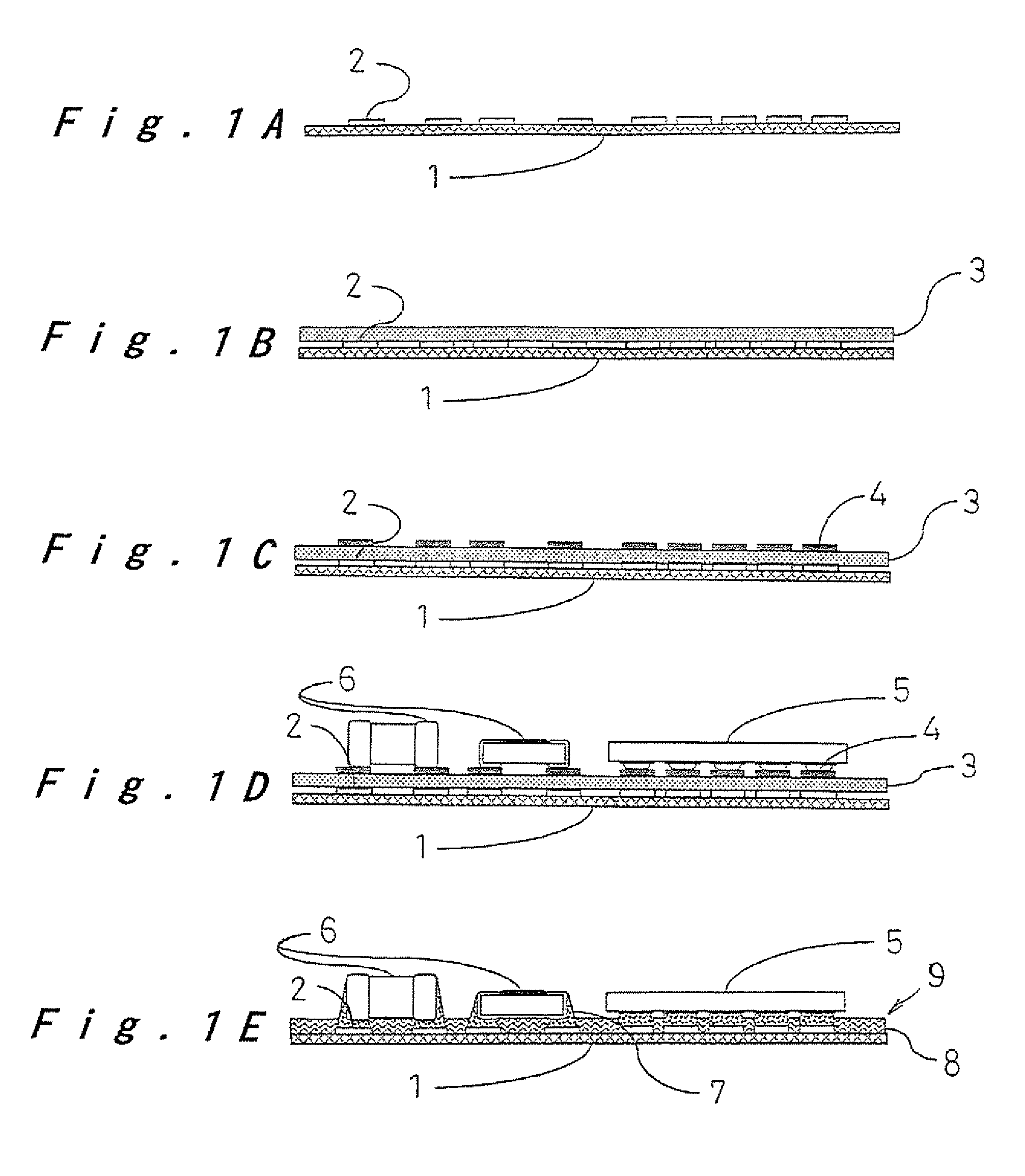Electronic component mounting method, and circuit substrate and circuit substrate unit used in the method
a technology of electronic components and mounting methods, which is applied in the direction of sustainable manufacturing/processing, final product manufacturing, cooking vessels, etc., can solve the problems of lowering joint strength, high cost, complex production process, etc., and achieves high joint reliability, good product quality, and reliable reinforcement
- Summary
- Abstract
- Description
- Claims
- Application Information
AI Technical Summary
Benefits of technology
Problems solved by technology
Method used
Image
Examples
first embodiment
[0061]FIG. 1A to FIG. 1E illustrate process steps of an electronic component mounting method in accordance with a first embodiment of the present invention. This is one embodiment of a component mounting method, in which 1.0×0.5 mm chip components 6 (hereinafter simply referred to as “electronic components 6”) and a WL-CSP (Wafer-Level CSP) 5 with 0.4 mm pitch electrodes (hereinafter simply referred to as “electronic component 5”) are mounted on a circuit substrate 1. Referring to FIG. 1A, the circuit substrate 1 is made of, for example, glass / epoxy resin, and includes gold-plated electrode lands 2 for bonding purposes. A resin sheet 3, which is not hardened vet, is laid on the circuit substrate 1, as shown in FIG. 1B, in a succeeding step. The resin sheet 3 is a 30 μm thick thermosetting resin sheet, which is cut to the same size as the entire circuit substrate 1, and bonded on the circuit substrate 1. The resin sheet 3 may be cut to the size of a region where the electronic compon...
second embodiment
[0068] Next, a second embodiment of the present invention will be described. In the following description of the embodiment, like elements to those of the previous embodiment are given the same reference numerals and will not be described again, and differences only will be described.
[0069] While thermosetting resin was used for the resin sheet 3 in the above-described first embodiment, thermoplastic resin is used in this embodiment for the resin sheet 3. With a thermoplastic resin sheet, the same effect of reinforcing the joints is achieved.
third embodiment
[0070] Next, a third embodiment of the present invention will be described with reference to FIG. 3. In this embodiment, the resin sheet 3 has a matrix of pores 10 with a diameter of, for example, 50 μm arranged at a constant interval of 50 μm. The diameter of the pores 10 may suitably be selected in the range of from several μm which corresponds to the particle size of solder paste 4 to as large as the size of the electrode lands 2.
[0071] In this embodiment, too, with the similar process steps of the first embodiment, the electronic components 5 and 6 are solder-bonded, and the joints are collectively reinforced. As the resin sheet 3 has equally spaced pores 10, it allows molten solder to flow through the pores 10 when the resin sheet 3 is softened in the heating period of about several to 350 seconds during the reflow process. Therefore the electrodes of the electronic components 5 and 6 are readily and reliably bonded to the electrode lands 2 on the circuit substrate 1 even if t...
PUM
 Login to View More
Login to View More Abstract
Description
Claims
Application Information
 Login to View More
Login to View More - R&D
- Intellectual Property
- Life Sciences
- Materials
- Tech Scout
- Unparalleled Data Quality
- Higher Quality Content
- 60% Fewer Hallucinations
Browse by: Latest US Patents, China's latest patents, Technical Efficacy Thesaurus, Application Domain, Technology Topic, Popular Technical Reports.
© 2025 PatSnap. All rights reserved.Legal|Privacy policy|Modern Slavery Act Transparency Statement|Sitemap|About US| Contact US: help@patsnap.com



